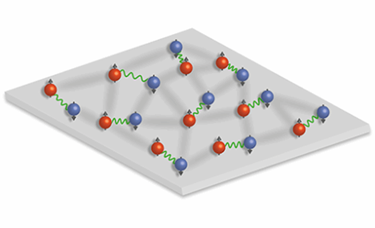Exploring The Phenomenon Of Superconductivity

Fermionic pairing at high temperatures: Heidelberg physicists succeed in proving an exotic matter state
Scientists at the University of Heidelberg have detected an exotic matter state with the aid of ultra-cold atoms. The underlying particles form pairs when their motion is restricted to two dimensions. These findings from quantum physics could provide important clues to better understand phenomena of superconductivity. The research results were published in the journal "Science".
Superconductors are materials in which current can flow without any resistance, when a so-called critical temperature is exceeded. However, the technologically particularly interesting class of high-temperature superconductors with unusually high transition temperatures is not fully understood. However, it has been proven that a certain type of particle - the fermions - must necessarily form pairs in order to become superconducting. Research has also shown that many materials that have superconducting properties at comparatively high temperatures have a layered structure. "This means that the motion of the electrons in such quantum systems is effectively limited to two dimensions," says project leader Prof. Dr. med. Selim Jochim of the Physics Institute of the University of Heidelberg. "However, the question was still open as to how pair formation combined with two-dimensionality can lead to higher transition temperatures."
To get to the bottom of this question, experiments with ultracold atoms were carried out at the Center for Quantum Dynamics. These atoms were trapped in two-dimensional traps generated by a focused laser beam. "In solids, such as copper oxides, there are many competing effects and also impurities that make these materials difficult to describe. Therefore, we use ultracold atoms to simulate the behavior of electrons in a solid. We are thus able to generate very pure samples and have full control over the crucial parameters of the system, "explains Puneet Murthy, Ph.D. student at the Center for Quantum Dynamics at the University of Heidelberg and one of the main authors of the publication.
A technique known as radio frequency spectroscopy was used in these experiments. The scientists are thus investigating how atoms respond to a radio-frequency pulse. In this way they could determine exactly when and in what form it came to a pairing. The measurements were also carried out for different interaction strengths between the fermions. In these investigations, the researchers encountered an exotic matter state. From theory it is known that weakly interacting fermions should form pairs at the same temperature where they also become superconducting. However, when the scientists increased the strength of the interactions in the experiments, they observed
"The long-term goal of our research is to gain a deeper understanding of these phenomena. For this we start with small systems, which we put together atom by atom, "says Selim Jochim. The research also involved scientists from the Institute of Theoretical Physics and researchers from Simon Fraser University in Vancouver, Canada.
Source: Heidelberg University
